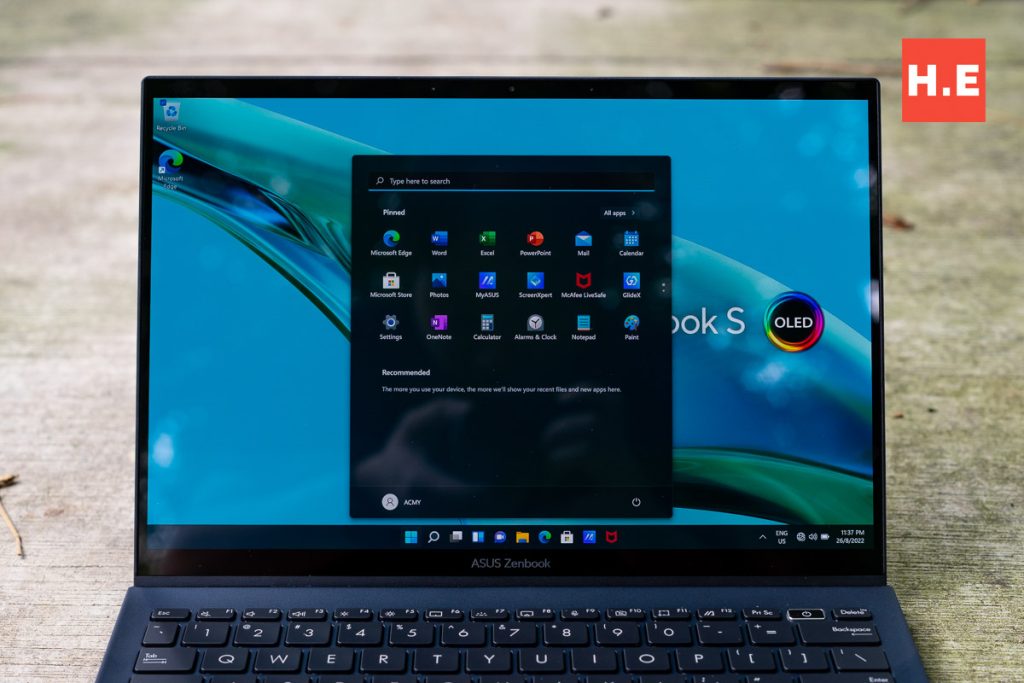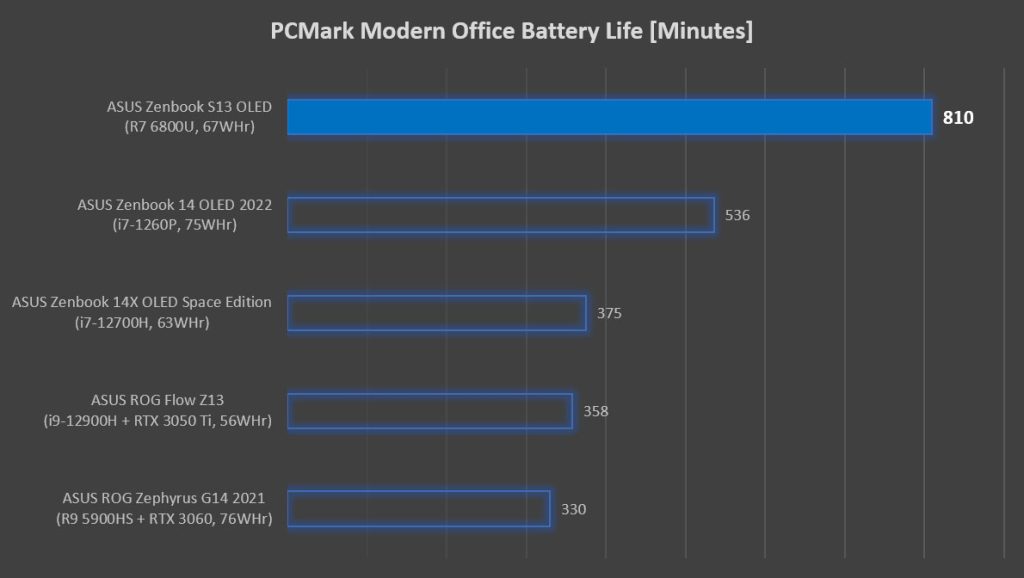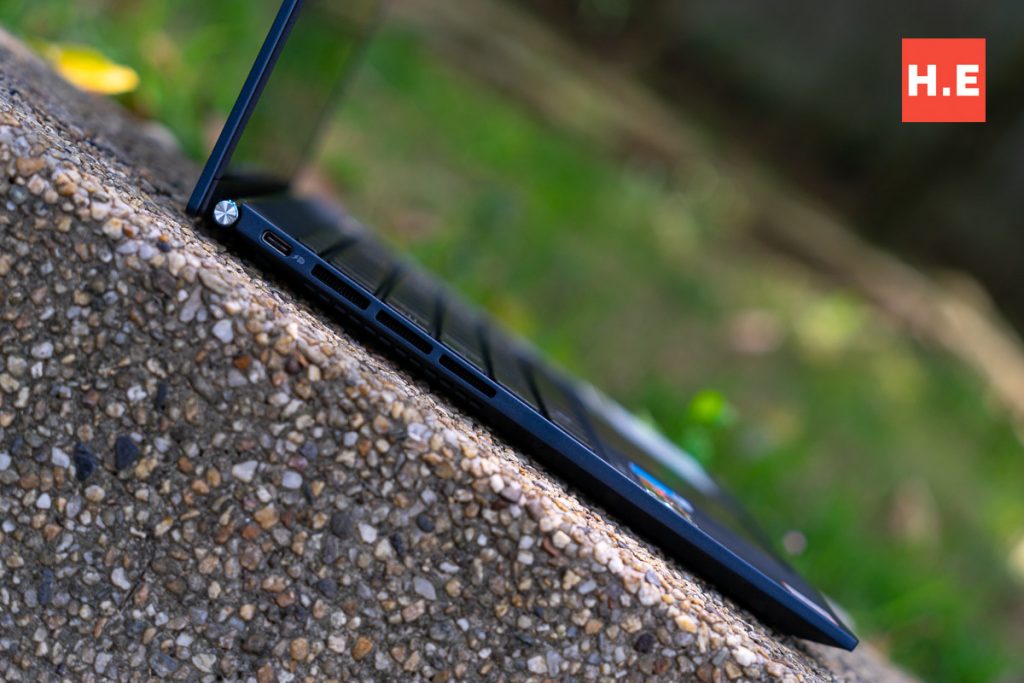
ASUS Zenbook S13 OLED Review — fantastic CPU, stifling display and ports

ASUS Zenbook S13 OLED (UM5302)
I won't deny that I am truly smitten by the sheer weightlessness, minimalist design, mind-blowing performance and battery life of the ASUS Zenbook S13 OLED (UM5302), but the lack of full-sized ports and cramped display just isn't for me.
- Minimalist design and weight
- Big keys for a small laptop
- The best 13.3″ display you have ever seen
- Tiny 65W charger
- Outstanding performance and efficiency
- Superb battery life
- Only USB-C ports
- Limited cooling capability
What does the AMD Ryzen 6000 series mobile processors bring to the table? Well, I have no idea either. But this premium 13-incher we have here today packs the Ryzen 7 6800U, and I am very interested to see not just how the processor performs, but also what ASUS can bring to the already premium Zenbook lineup for the ASUS Zenbook S13 OLED (UM5302) to deserve the “S” in its name.
ASUS Zenbook S13 OLED — What’s Good?
Minimalist design and weight

If you thought the ASUS Zenbook 14 OLED looked premium, well you haven’t seen nothing yet. Instead of the Kintsugi-inspired design, the Zenbook S13 OLED comes with the new ASUS monogram like the Zenbook Pros we checked out recently. But instead of setting the logo in ASUS’ signature brushed concentric circles, we get a rougher matte Ponder Blue finishing here for the entire magnesium-aluminum unibody. This coarser surface is more akin to the ASUS ExpertBooks’ finishes than any other Zenbook we have seen.

The 180-degree hinge comes as a part of a fancy chromed tube-like extension from the lower half, with concentric circles on both ends. This round protrusion stands in stark contrast to the sharp angular lines elsewhere on the chassis, but I guess it adds a touch of softness to an otherwise “hard” design, if you get my drift. And the most impressive thing is of course that the Zenbook S13 OLED weighs just 1.1kg thanks to the exotic magnesium-aluminum build, which is honestly mind-blowing considering that this has a glass touchscreen, and a decently-sized 67WHr battery.
Big keys for a small laptop

ASUS has already perfected the art of packing full-sized keyboards in small form factors, and the Zenbook S13 OLED benefits from all that experience. We have large keys with the proper spacing between them, and also sufficient travel distance here, which makes for a great typing experience. And we have the all-important PrtSc key as well, so that’s surely a major win here for me. For those who do a lot of number entry, the NumberPad feature in the sizeable trackpad is also going to come in handy. Honestly, the trackpad looks like it was transplanted from a much larger model. Just see how close it gets to the edges of the chassis!
The best 13.3″ display you have ever seen

A 14″ 2.8K panel is already really sharp, but 13.3″ takes things even further. And of course, ASUS made sure that this is a fantastic display for creators, with 100% DCI-P3 gamut coverage and PANTONE Validated color accuracy, along with all the other benefits of OLED panels in tow. It is touch sensitive as well, with support for the included ASUS Pen 2.0, giving creators an additional avenue to unleash their creativity. The glossy Corning Gorilla Glass protection over the display means that using it outdoors can be challenging, although having the 550 nits peak brightness helps a fair bit.

My only real issue with the display here is that I want more of this awesomeness. 13 inches is just not enough. The 16:10 aspect ratio helps a little, but having used the recent slew of 16:10 14-inchers from ASUS recently, and the 16″ MateBook D16, I would give up some of the portability on offer here for just an extra inch (or two) in a heartbeat. Which is probably something that many men would be willing to as well, but I digress.
Tiny 65W charger

I intentionally put all the included accessories on the ASUS ZenBook S13 OLED’s keyboard, with the 65W USB charger in in the corner of the shot. You might have even missed it if you weren’t paying attention. It’s just that small. Heck, the 60W+ chargers that some smartphones today come with are even larger than this. The charger outputs via a USB-C port, with a long USB-C cable included for all your charging needs — laptop, or otherwise. Kudos to ASUS to moving beyond their already compact square power bricks that have fixed cables.
Outstanding performance and efficiency
The Zenbook S13 OLED’s Ryzen 7 6800U puts up a fantastic showing, with the Radeon 680M debuting raytracing in an integrated graphics solution, and delivering fantastic performance at that. We are seeing performance on par with the GeForce RTX 3050 Ti here! Versus Intel’s full-fat 96EU Iris Xe graphics, we are seeing nearly 20% higher performance from the Radeon 680M, but at a fraction of the power (28W vs 45W). This is some amazing stuff and I can’t wait to see AMD pair this iGPU with beefier CPU cores.
With that said, the Zen 3+ cores at play here aren’t all that bad. The AMD Ryzen 7 6800U is 10% faster in terms of multi-core performance in the same 28W power envelope versus the Zenbook 14 OLED’s Core i7-1260P. Notably, Zen 3+ doesn’t quite have the same single-core prowess that we get with the Golden Cove cores in the 12th Gen Intel Core processors, with the Zenbook 14 OLED coming up 12% faster. However any workload that will noticeably benefit from CPU performance will usually be optimized for multithreading. Single-threaded performance is usually important only for gaming, which clearly isn’t a focus for these ultraportables discussed here.
Superb battery life

All that efficiency enables insanely good battery life. We are looking at 13.5 hours of battery life in PCMark 10, blowing past any of the competition by a significant amount. In real life usage I was looking at 8 to 10 hours depending on what I was doing. In essence, this is a laptop that you can bring out for a full work day without worrying about a charger. And even if you needed to bring the charger out, it’s really tiny. The Ryzen 7 6800U is definitely a fantastic choice for the Zenbook S13 OLED.
ASUS Zenbook S13 OLED — What’s Not?
Only USB-C ports

Call me spoiled. But after years of ASUS bragging about how their ultraportable Zenbooks come with a “full complement of I/O ports” — with the exception of a headphone jack — the ASUS Zenbook S13 OLED’s trio of USB-C ports looks really bad. Yes, all of them are fast 10Gbps ports, and yes, all of them support both display output to USB-PD charging, but to use a simple mouse, you will already need to whip out the included USB-C to USB-A dongle. Unless you already have a set of dongles lying around, this laptop will prove to be quite frustrating to use. This is not the way.

Speaking of dongles, I do appreciate the included one, but I think ASUS should at least have bundled a USB-C to HDMI dongle too. When was the last time you saw a projector with a USB-C input lying in an office meeting room? Yeah, me neither. I guess this is the main casualty of the sheer compactness of the design. However, once you consider how the Zenbook 13 (UX325) has a marginally smaller footprint, is 1mm thinner and yet comes with a full-sized HDMI and USB-A ports as well as a microSD card slot — with the exception of a headphone jack — you begin to wonder why didn’t ASUS offer the same here. Oh, by the way, you do have a headphone jack here.
Limited cooling capability

The pursuit of thinness also seems to have claimed another victim — cooling. While the AMD Ryzen 7 6800U proved to deliver extremely efficient performance, you can get some seriously high temperatures with the Zenbook S13 OLED. Average CPU temperatures hovered at around 83°C under load, while peak temperatures were a toasty 95.3°C. This was with the CPU pulling 30W during its initial boost phase, before slowly tapering down to just 17W. Under all that load, the laptop’s keyboard deck does get rather uncomfortable, but I would assume that not many people would be compressing videos, rendering with OpenCL and manipulating images at the same time on this small a laptop, so most users should be perfectly fine with the Zenbook S13 OLED.
ASUS Zenbook S13 OLED (UM5302) Specifications
| Processor | AMD Ryzen 7 6800U, 8C/16T @ up to 4.7GHz 28W TDP 16MB L3 cache 6nm FinFET TSMC |
| Memory | 16GB LPDDR5-6400, on-board, quad-channel |
| Graphics | AMD Radeon 680M, 12CU @ up to 2.2GHz |
| Storage | 1TB Samsung PM9A1 SSD (M.2 PCIe 4.0×4 NVMe SSD, NVMe 1.3) |
| Display | 13.3″ 2.8K 16:10 (2880 x 1800) 60Hz OLED Samsung ATNA33AA03 display 550 nits peak brightness, 100% DCI-P3 gamut, PANTONE Validated 89% screen-to-body ratio, touch and stylus support |
| Connectivity | WiFi 6E + Bluetooth 5.2 (MediaTek MT7922) 3 x USB-C (USB 3.2 Gen 2, 10Gbps) with display-out, USB-PD 1 x 3.5mm combo jack |
| Audio | Stereo speakers with Smart Amp Technology harman/kardon (Premium) Array microphone |
| Power | 67WHr 4-cell Li-ion battery 65W USB-C (USB-PD) power adapter |
| Dimensions | 296.7 x 210.5 x 14.9 mm |
| Weight | 1.1kg |
| Included Accessories | Sleeve USB-C to USB-A dongle ASUS Pen 2.0 stylus |
ASUS Zenbook S13 OLED — should you buy this?

If you want a really lightweight 13-inch laptop with insanely good battery life and performance, this is it. For RM5999, it is reasonably priced for an ultrathin, ultralight machine, but I need to recommend you to try it out first, if you can. 13-inchers aren’t exactly for everyone, and many people I know stuck with one usually wish for a larger display. I won’t deny that I am truly smitten by the sheer weightlessness, minimalist design, mind-blowing performance and battery life of the ASUS Zenbook S13 OLED (UM5302), but the lack of full-sized ports and cramped display just isn’t for me.

Unless the extra battery life, portability and graphics performance is really important to you, I would point you towards the Zenbook 14X OLED Space Edition or Zenbook 14 OLED. You get competitive CPU performance, larger (14″) and faster (90Hz) displays and most importantly, more ports, all for 300 grams more. Now, the unspeakable things I would do for a Zenbook 14X OLED Space Edition with an AMD Ryzen 7 6800HS…
















[…] I really like about the ExpertBook B9 is that this laptop doesn’t sacrifice much, unlike the ASUS Zenbook S13 OLED that had to give up screen size and usable ports to hit its 1.1kg […]
[…] its cousin, the Zenbook S13 OLED, the Zenbook 14 Flip OLED comes with only a handful of I/O ports: 1x USB 3.2 Gen 2 Type-A, 2x […]